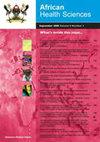乌干达穆拉戈国家转诊医院眼科诊所传统眼药使用者的眼部并发症及相关因素
IF 0.9
4区 医学
Q3 MEDICINE, GENERAL & INTERNAL
引用次数: 0
摘要
背景:在过去的几十年里,全世界使用传统眼药(TEM)的人数急剧增加,有几个因素迫使患者使用传统眼药。 研究目的我们在穆拉戈国家转诊医院(Mulago National Referral Hospital,MNRH)眼科诊所开展了一项研究,以确定传统眼药的类型、眼部并发症以及传统眼药使用者的相关因素。 方法和材料:2021年6月至8月在MNRH眼科诊所对传统眼药使用者进行的医院横断面研究。使用 Epi Data 4.2 版和 STATA 15 版进行分析。使用带稳健标准误差的修正泊松回归来确定相关因素。 结果:共登记了 182 名 TEM 用户(男性:53.3%),平均年龄(36±21SD)岁。最常使用的 TEM 类型是植物产品(47.8%)。70%的 TEM 使用者有眼部并发症,最常见的表现是结膜炎(53.9%)。眼部并发症与居住在城市地区(p< 0.006)和报告容易获得 TEM 的参与者(p< 0.001)明显相关。 结论植物性产品是最常使用的TEM类型,大部分TEM使用者被发现患有威胁视力的眼部并发症。 关键词:传统眼药;乌干达;并发症传统眼药;乌干达;并发症本文章由计算机程序翻译,如有差异,请以英文原文为准。
Ocular complications and associated factors among traditional eye medicines users attending the eye clinic at Mulago national referral hospital, Uganda
Background: Over the past decades there has been a phenomenal increase in the use of Traditional Eye medicines (TEM) worldwide and there are several factors that compel patients to use TEM. Objectives: We conducted a study to determine the types of traditional eye medicine, ocular complications, and associated factors among traditional eye medicine users at the Mulago National Referral Hospital (MNRH) eye clinic. Methods and Materials: A hospital-based cross-sectional study among TEM users at MNRH eye clinic from June to August 2021. Epi Data version 4.2 and STATA version 15 used for analysis. A modified Poisson regression with robust standard errors was used to determine the associated factors. Results: Overall, 182 TEM users (males:53.3%) were enrolled, with a mean age of 36±21SD years. The most frequently used type of TEM were plant products (47.8%). 70% of TEM users had ocular complications, the most frequent manifestation was conjunctivitis (53.9%). Ocular complications were significantly associated with living in the urban areas (p< 0.006) and participants who reported ease and availability of TEM (p < 0.001). Conclusion: Plant-based products were the most frequently used types of TEM, a large proportion of the TEM users were found with sight-threatening ocular complications. Keywords: Traditional eye medicine; Uganda; Complications.
求助全文
通过发布文献求助,成功后即可免费获取论文全文。
去求助
来源期刊

African Health Sciences
MEDICINE, GENERAL & INTERNAL-
CiteScore
2.30
自引率
0.00%
发文量
179
审稿时长
>12 weeks
期刊介绍:
The African Health Sciences is an internationally refereed journal publishing original articles on research, clinical practice, public health, policy, planning, implementation and evaluation, in the health and related sciences relevant to Africa and the tropics. Its objectives are to: Advocate for and promote the growth of reading culture in sub Saharan Africa; Provide a high quality journal in which health and policy and other researchers and practitioners in the region can and world wide, can publish their work; Promote relevant health system research and publication in the region including alternative means of health care financing, the burden of and solution of health problems in marginalized urban and rural communities amongst the displaced and others affected by conflict; Promote research and the systematic collection and collation and publication of data on diseases and conditions of equity and influence; Promote development of evidence-based policies and guidelines for clinical, public health and other practitioners. African Health Sciences acknowledges support provided by the African Health Journals Partnership Project that is funded by the US National Institutes of Health (through the National Library of Medicine and the Fogarty International Center) and facilitated by the Council of Science Editors.
 求助内容:
求助内容: 应助结果提醒方式:
应助结果提醒方式:


